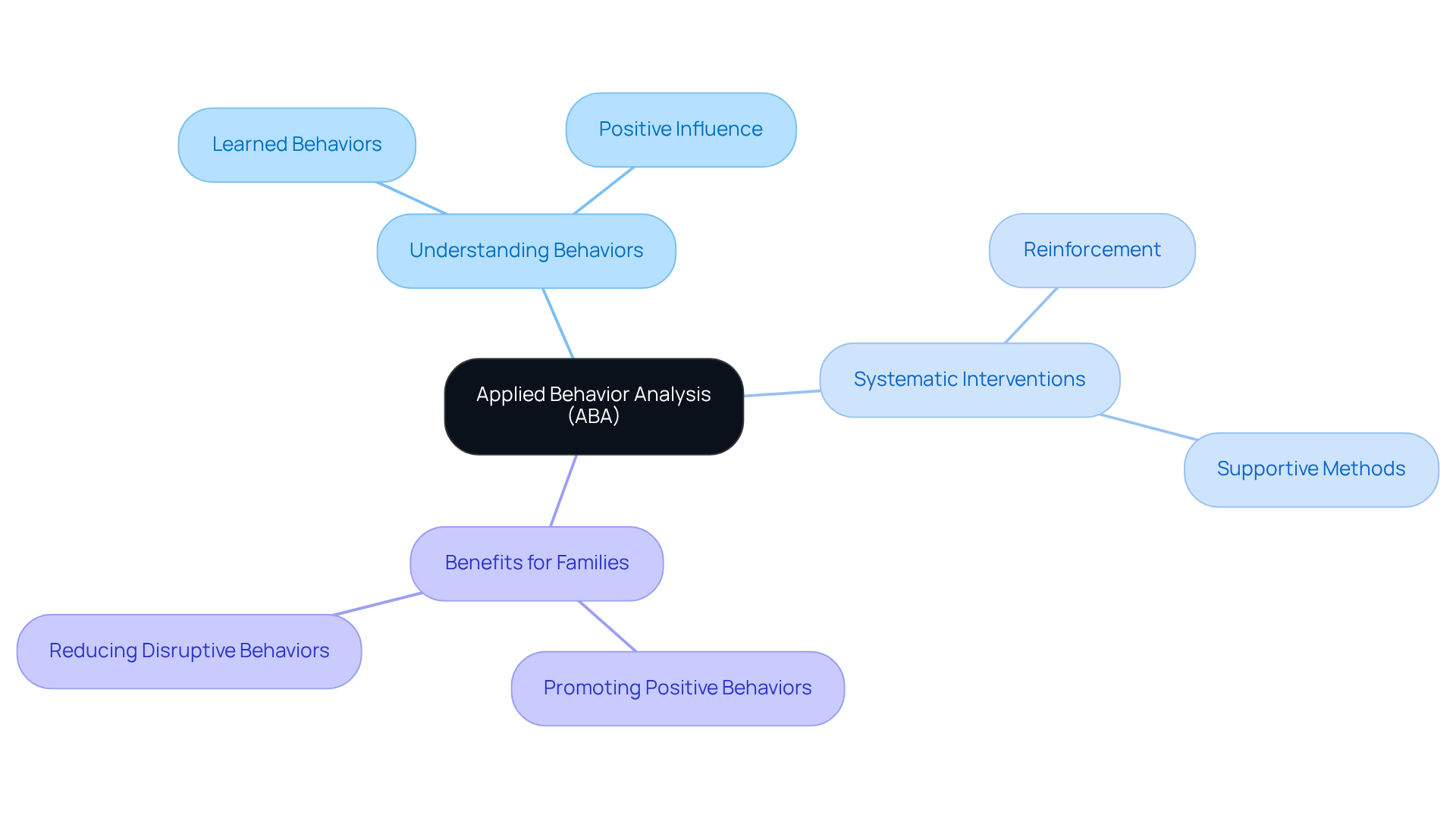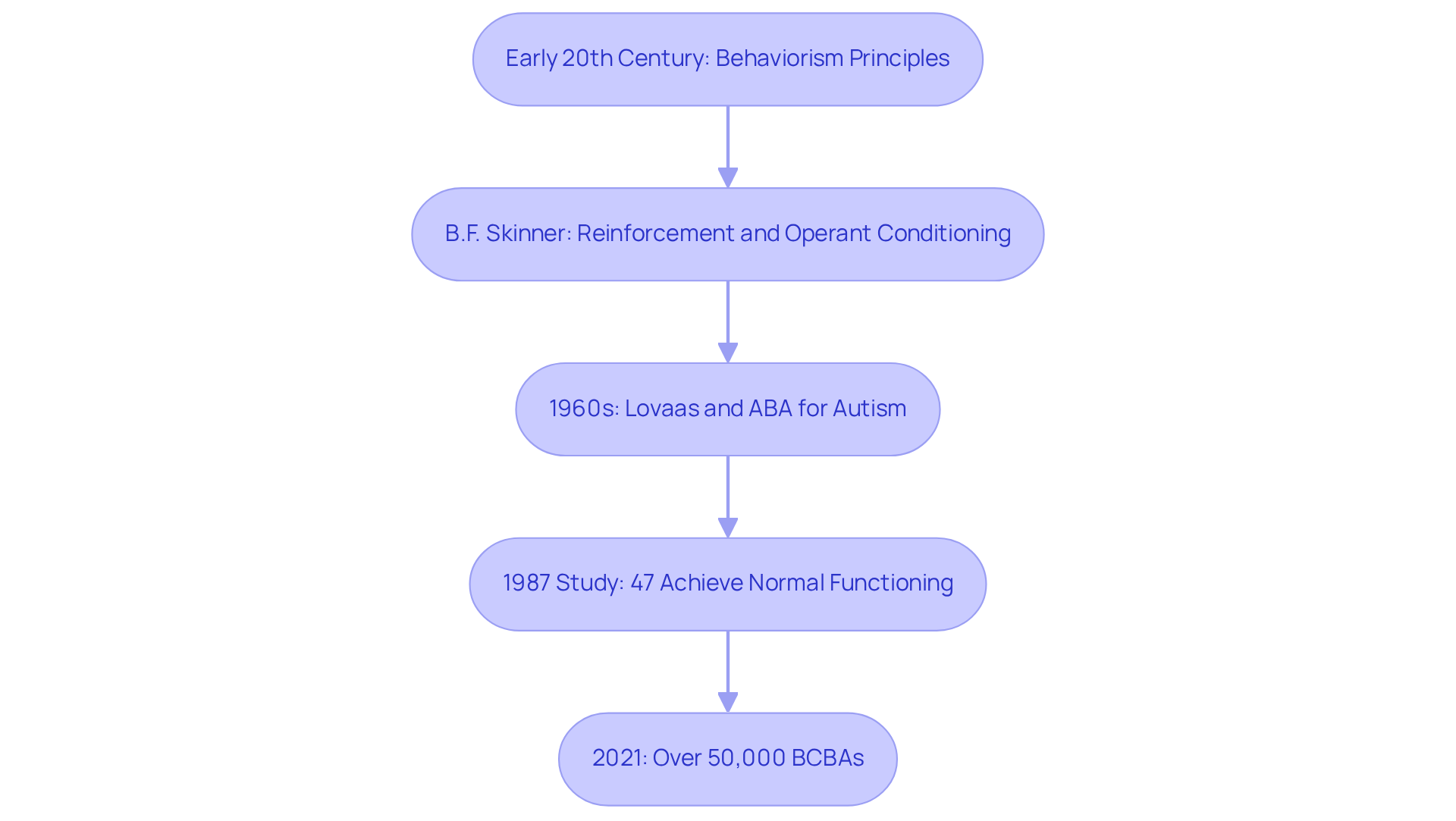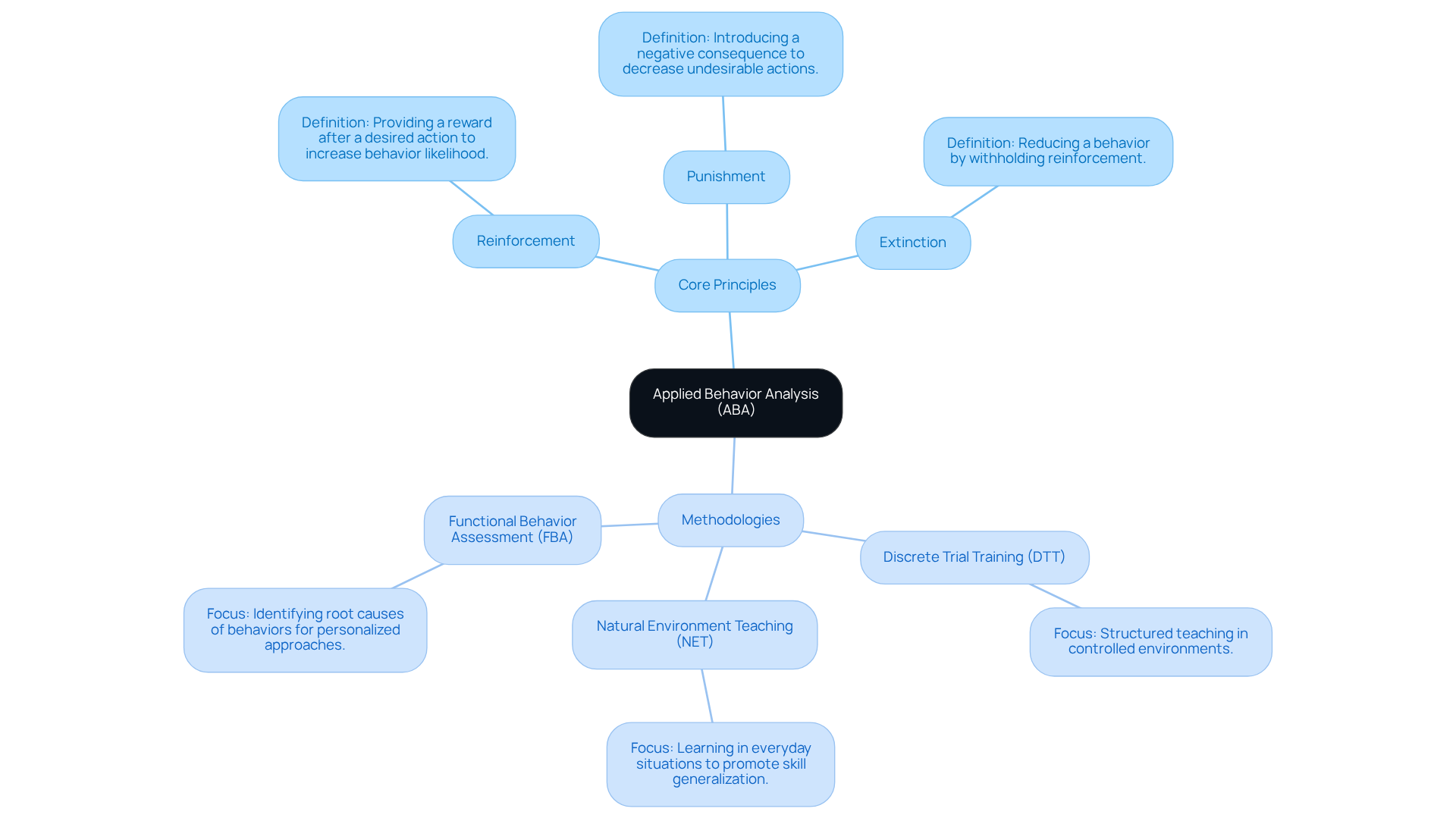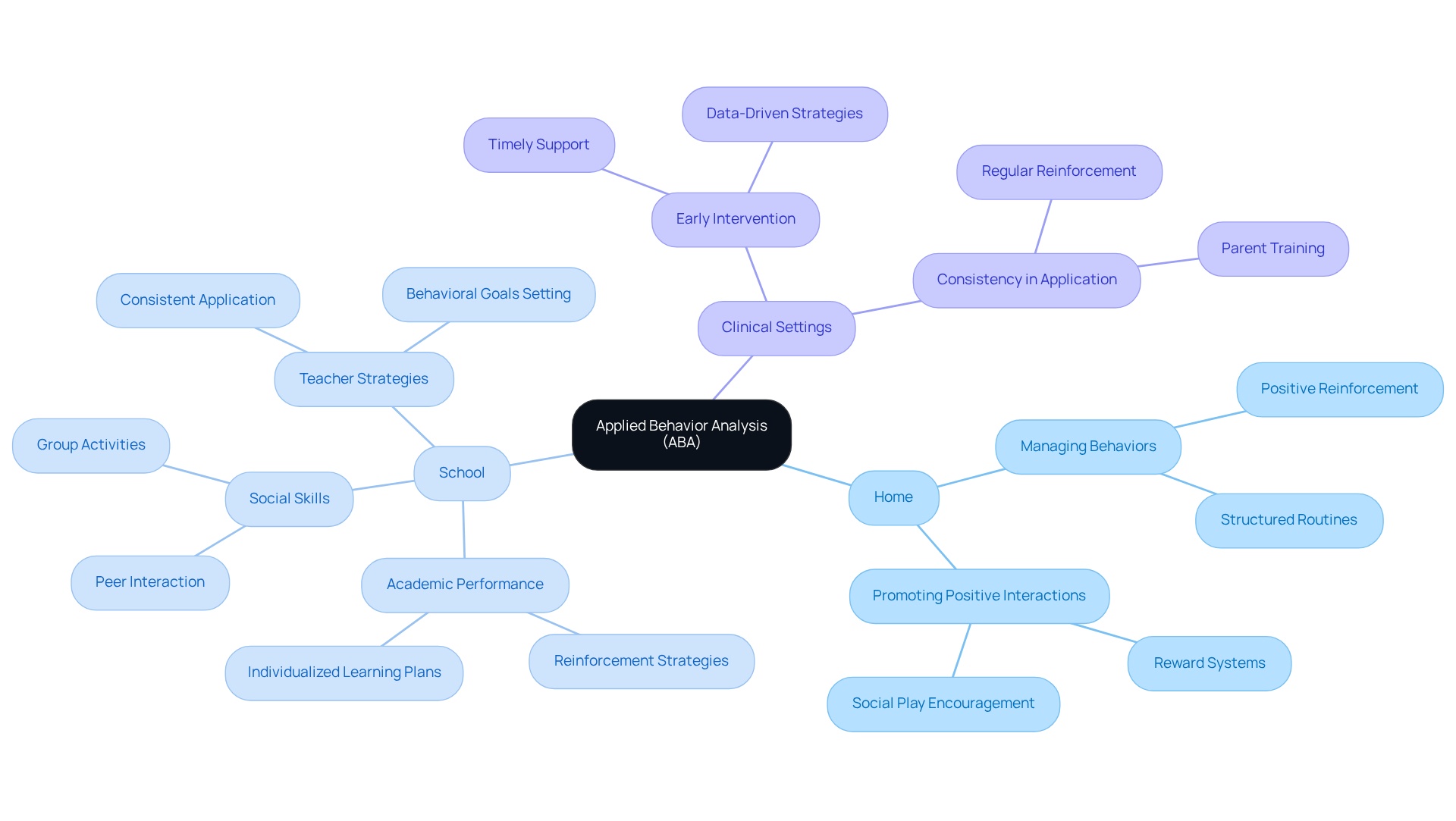Overview
Applied Behavior Analysis (ABA) is a compassionate and systematic approach within psychology that seeks to understand and modify behaviors through reinforcement and supportive methods. This is especially beneficial for individuals with autism and developmental disorders. In this article, we explore the historical context of ABA, its core principles, and practical applications. We aim to demonstrate its effectiveness across various settings, showcasing significant improvements in behavior and learning outcomes, particularly when interventions are implemented early on.
As parents, understanding ABA can feel overwhelming, but it is essential to know that this approach is designed to nurture and support your child's development. By focusing on positive reinforcement and tailored interventions, ABA helps children thrive in their unique learning environments. We will share stories and examples that illustrate the challenges faced by families and the transformative impact of ABA.
We encourage you to consider the possibilities that ABA offers. By engaging with this method, you can witness remarkable changes in your child's behavior and learning journey. Together, let’s explore how early intervention can make a difference and empower you with the resources needed to support your child’s growth.
Join us in this exploration of ABA, and feel free to share your experiences or questions in the comments. Your journey matters, and we are here to provide guidance and support as you navigate this path.
Introduction
Applied Behavior Analysis (ABA) is a crucial approach within psychology, offering a structured way to understand and change behavior. This evidence-based practice not only supports families navigating the complexities of autism and developmental disorders but also highlights the significance of data-driven interventions. Yet, as the field advances, challenges like financial barriers and the need for skill generalization remain, prompting vital questions about accessibility and effectiveness.
How can families harness ABA to foster lasting positive changes in their children's lives while overcoming these obstacles? By exploring the journey of ABA, we can uncover the tools and resources that empower families to create meaningful transformations.
Define Applied Behavior Analysis (ABA)
Applied Behavior Analysis (ABA), which falls under the umbrella of psychology applied behavior analysis, is a compassionate approach that focuses on understanding and changing behaviors through systematic interventions.
Rooted in the principles of psychology applied behavior analysis, ABA recognizes that behaviors are learned and can be positively influenced through reinforcement and other supportive methods. This approach, based on psychology applied behavior analysis, is particularly beneficial for families facing the challenges associated with autism and other developmental disorders. It aims to promote positive behaviors while gently reducing those that may be harmful or disruptive.
What makes ABA truly effective is its data-driven nature. By observing and measuring behaviors, practitioners can evaluate the impact of their interventions and make thoughtful adjustments. This process not only supports the individual but also provides families with insights into their loved ones' progress.
If you're seeking to understand how ABA can make a difference in your child's life, consider exploring resources that offer guidance and support tailored to your needs.

Explore the Historical Context of ABA
The journey of Applied Behavior Analysis (ABA) began in the early 20th century, deeply rooted in the principles of behaviorism championed by psychologists John B. Watson and B.F. Skinner. Watson's focus on observable behavior rather than internal mental states laid the groundwork for behaviorist theories, suggesting that behavior could indeed be studied scientifically. Building upon this foundation, B.F. Skinner introduced pivotal concepts such as reinforcement and operant conditioning, which have become essential in shaping ABA practices.
In the 1960s, O. Ivar Lovaas brought ABA to the forefront as a therapy specifically designed for children with autism. His innovative strategies showcased the effectiveness of ABA, demonstrating through landmark studies that intensive behavioral intervention could lead to significant improvements in communication and social skills. Remarkably, his 1987 study revealed that 47% of children achieved 'normal functioning' after receiving ABA treatment, a testament to the potential of this approach.
Since its inception, ABA has evolved considerably, continually integrating ongoing research and adapting to various environments, including schools, clinics, and home settings. Today, approximately 71% of school districts report utilizing some form of ABA-based methods, highlighting its growing presence in educational settings. This adaptability has fostered widespread acceptance of psychology applied behavior analysis as a leading approach in special education, particularly in meeting the needs of children with autism.
The expansion of ABA treatment has been nothing short of remarkable. The number of Board Certified Behavior Analysts (BCBAs) has surged from just a few hundred in 2000 to over 50,000 by 2021, reflecting the increasing demand for effective autism interventions. Today, psychology applied behavior analysis is recognized not only for its structured methodologies but also for its commitment to enhancing the quality of life for individuals with autism and their families.
However, it's important to acknowledge the challenges families face. Many encounter significant financial burdens, with average yearly out-of-pocket costs for ABA services reaching $18,000, even with insurance coverage. Furthermore, research indicates that about 40% of children receiving traditional ABA therapy struggle to generalize skills across different settings. This underscores the pressing need for continued improvement in methodologies, ensuring that every child receives the support they truly deserve.
As parents, your experiences and stories matter. We invite you to share your journey and insights in the comments or through our newsletters, fostering a community of support and understanding.

Outline Core Principles and Methodologies of ABA
Understanding the core principles of psychology applied behavior analysis can be incredibly beneficial for parents seeking to support their children. At its heart, ABA encompasses:
- Reinforcement: This is all about providing a reward after a desired action, which helps increase the likelihood of that behavior occurring again.
- Punishment: This seeks to decrease undesirable actions by introducing a negative consequence.
- Extinction: This involves reducing a behavior by withholding reinforcement, gradually leading to its decline over time.
ABA methodologies offer various techniques that can be tailored to your child's needs. These include:
- Discrete Trial Training (DTT): This focuses on structured teaching in controlled environments.
- Natural Environment Teaching (NET): This emphasizes learning in everyday situations, which promotes the generalization of skills.
- Functional Behavior Assessment (FBA): This is another valuable tool, as it helps identify the root causes of behaviors, allowing for personalized approaches that truly resonate with each child's unique circumstances.
These methodologies are designed to be flexible and adaptable, giving practitioners the ability to modify strategies based on ongoing assessments and data collection. Continuous data tracking is essential; it provides insights into how effective interventions are and informs necessary adjustments. Research has shown that psychology applied behavior analysis therapy, particularly through methods like DTT and NET, can lead to significant improvements in behavioral outcomes for children with autism and ADHD. This highlights the importance of evidence-based practices in creating meaningful change.
As you navigate this journey, remember that support and resources are available to help you every step of the way. Sharing experiences and learning from one another can foster a sense of community and understanding. If you have questions or would like to share your thoughts, please feel free to reach out. Together, we can make a positive impact on our children's lives.

Discuss Practical Applications of ABA in Various Settings
Psychology applied behavior analysis (ABA) is a powerful tool that can be effectively utilized in various environments, such as homes, schools, and clinical settings. In educational contexts, psychology applied behavior analysis techniques are crucial for enhancing both academic performance and social skills for students with autism. For instance, teachers often use reinforcement strategies to encourage participation and engagement in classroom activities, which can lead to improved learning outcomes. At home, parents can implement ABA techniques to manage challenging behaviors and promote positive interactions. Research indicates that children who receive early support through psychology applied behavior analysis experience a remarkable 60% reduction in challenging behaviors within just six months, underscoring the vital importance of early intervention for achieving favorable results.
Real-world examples vividly illustrate how ABA can be applied at home. Parents can create structured routines and use positive reinforcement to encourage desired behaviors, such as completing homework or engaging in social play. For example, a parent might establish a reward system to motivate their child to share toys with siblings, reinforcing those positive social interactions. Additionally, data reveals that children who begin therapy based on psychology applied behavior analysis before the age of three experience an average 17-point increase in IQ scores, highlighting the long-term benefits of early intervention and the significance of starting therapy at a young age.
Practitioners emphasize the necessity of consistency when applying ABA strategies at home. Dr. Fayge Orzel notes that 'the key to effective conduct management is the regular use of reinforcement and clear expectations.' This consistency not only supports behavior modification but also strengthens the parent-child relationship, alleviating stress for families. Ultimately, the adaptability of psychology applied behavior analysis enables it to be tailored to meet the unique needs of individuals, making it an invaluable approach across diverse contexts.

Conclusion
Applied Behavior Analysis (ABA) represents a transformative approach within psychology, focusing on understanding and modifying behavior through systematic interventions. This compassionate methodology not only meets the needs of individuals with autism and developmental disorders but also empowers families by promoting positive behaviors and reducing disruptive ones. By utilizing data-driven practices, ABA practitioners can tailor interventions to maximize effectiveness, significantly enhancing the quality of life for those they serve.
As we reflect on the journey of ABA, it’s important to recognize how it has evolved from the foundational theories of behaviorism to become a widely accepted therapeutic practice. Pioneering work, such as that of O. Ivar Lovaas in the 1960s, has demonstrated the profound impact of ABA on children's communication and social skills. The growing adoption of ABA in educational settings and the increase in certified professionals underscore its significance in modern therapeutic practices. Yet, challenges such as financial burdens and the need for skill generalization remind us of the areas that require continued improvement and innovation within the field.
As our understanding of ABA deepens, we must acknowledge its potential to foster positive change across various environments. Parents, educators, and practitioners are encouraged to collaborate, share their experiences, and implement evidence-based strategies tailored to individual needs. By embracing the principles of Applied Behavior Analysis, we can build a supportive community that not only aids children in their developmental journeys but also advocates for ongoing advancements in methodologies and accessibility. Together, let’s continue to nurture this vital field, ensuring that every child receives the support they deserve.
Frequently Asked Questions
What is Applied Behavior Analysis (ABA)?
Applied Behavior Analysis (ABA) is a compassionate approach within psychology that focuses on understanding and changing behaviors through systematic interventions.
What principles does ABA rely on?
ABA is rooted in the principles of psychology that recognize behaviors as learned and can be positively influenced through reinforcement and supportive methods.
Who can benefit from ABA?
ABA is particularly beneficial for families dealing with challenges associated with autism and other developmental disorders.
What are the goals of ABA?
The goals of ABA include promoting positive behaviors while gently reducing harmful or disruptive behaviors.
How does ABA measure effectiveness?
ABA is data-driven, meaning practitioners observe and measure behaviors to evaluate the impact of their interventions and make necessary adjustments.
What insights does ABA provide to families?
ABA provides families with insights into their loved ones' progress, helping them understand the effectiveness of the interventions being applied.
Where can I find more information about ABA?
You can explore resources that offer guidance and support tailored to your needs to understand how ABA can make a difference in your child's life.




